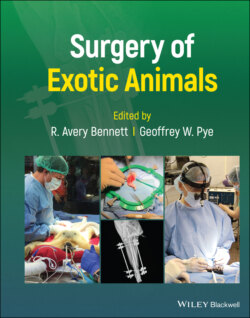Читать книгу Surgery of Exotic Animals - Группа авторов - Страница 84
Hand Position
ОглавлениеProper hand position is critical to placement of microsutures and accurate use of microsurgical instruments in small spaces and helps to limit fatigue and tremor during procedures.
Hands should be placed properly relative to the surgeon's ideal OHP as discussed earlier. This position is relaxed and balanced during the operative procedure. The OHP may be used to adjust the table height and stool height when using an operating microscope and to determine the ideal working distance when using surgical loupes.
Hands should be positioned properly relative to the surgical table. The surgeon's elbows and forearms should rest on the surgical table at an approximate angle of 90° from the shoulders. This can prove difficult when the patient is placed on the table and a sterile drape is applied to the patient but is critical for ergonomics and endurance. Tremor can persist if the surgeon's hands remain elevated from the table. An elevated hand position induces contraction of antebrachial musculature and eventual muscle fatigue and tremor despite a resting antebrachial and elbow position. To achieve the greatest stability and reduction of tremor, the surgeon's wrists and fifth digits of each hand should also rest on the surgical table or patient, and the fingers should be stacked on top of each other or splayed (Figures 3.12 and 3.14). If it is not possible for the wrists and fifth digits to rest on the table or patient, sterilizable hand rests may permit resting the entire hand.
Figure 3.14 Alternate stable hand position with fingers splayed instead of stacked on one another.
Figure 3.15 The surgeon's thumb and first two fingers should surround the instrument in a three‐point pencil hold, and the thumb and each digit should touch each other.
Lastly, hands should be positioned properly relative to the surgical instruments. When holding a microsurgical needle driver, forceps, or scissor, the surgeon's thumb and first two fingers should surround the instrument in a three‐point pencil hold, and the thumb and each digit should touch each other (Figure 3.15). By touching each other, the thumb and digits serve to stabilize one another. The thumb and digits should grasp the instrument about 2–3 cm from the tip of the instrument. This allows enough instrument to protrude from the hold for the instrument to be seen sufficiently in the field of view and provides stability to the end of the instrument, reducing tremor while permitting extension into the small body cavity of a bird, reptile, or fish.
